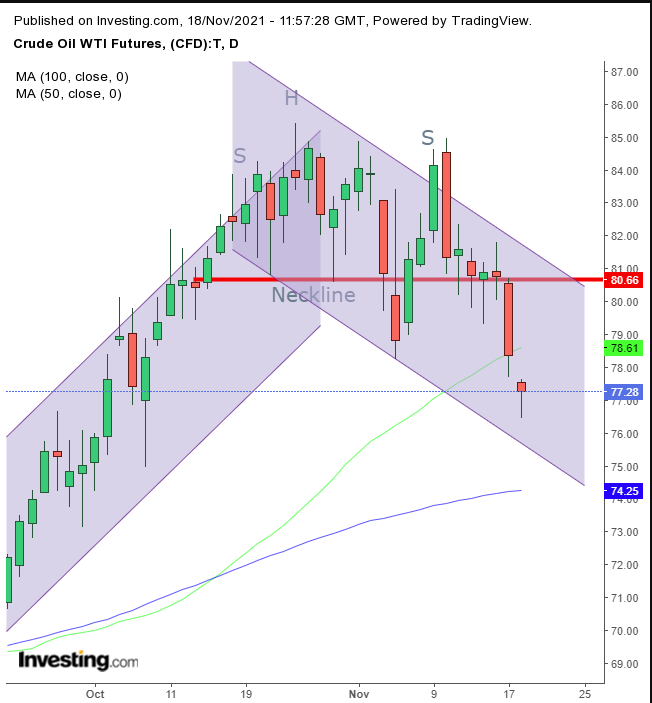Oil prices plunged out of the gate on Thursday, with the commodity opening lower, extending the current decline for a third day.
The panicked selloff was triggered by a report that, not only was US President Joseph Biden considering tapping into the country's emergency reserves in order to lower prices, he was also "asking large consuming nations to consider a stockpile release" to further cool overheated prices. The Reuters report said the President had approached countries like China and Japan—among the world's biggest oil consumers—asking them to participate.
Does that mean now is a good time to go short oil futures? Technicals aren't providing decisive signals.

WTI may have completed an H&S top, signaled by the price action as the trend reverses. We're not sure there's any significance however, to the Nov. 4 low that deviated from the pattern. Perhaps, it was a fakeout a bear trap.
The commodity's price fell below the 50 DMA for the first time since Sept. 10, increasing the odds of momentum weighing on oil toward the 100 DMA below $75, a critical psychological price level.
However, while all the indicators already provided a signal in October that the price could be heading lower, this still may not be the best time to short.
Even if prices are slipping, it won't occur in a straight line. They generally swing in a pendulum that moves from trader greed to fear, creating ebbs and flows within every trend, including one that's falling.
Case in point: the price neared the bottom of a falling channel and has come off its lows, forming a hammer (pending a close). That means the price could rebound in a return move to retest the bearish pattern.
Trading Strategies
Conservative traders should wait for the price to retest the neckline of the H&S and find resistance.
Moderate traders would wait for the same bounce for a better entry if not for confirmation.
Aggressive traders could enter a contrarian long trade, going long on a presumed rebound, before joining the rest of the market on the way down along with the trend. Money management is vital. Here's an example of what a basic trade plan should include:
Trade Sample – Contrararian Long Position
- Entry: $77
- Stop-Loss: $76.50
- Risk: $0.5
- Target: $80
- Reward: $3
- Risk:Reward Ratio: 1:6
Author's Note: This is just a sample in order to showcase the essential points of a trading plan. However, learning to draw a plan that suits your specific needs, including timing, budget and temperament is a must. Until you understand how to do so, use our samples. Nevertheless, trading profitably comes with the ability to manage risk to cut losses and run with wins. Pros don't assume they know the future rather they learn to operate with statistics.
